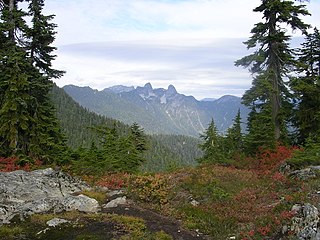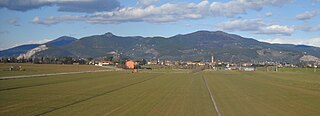Related Research Articles

The Italian Riviera or Ligurian Riviera is the narrow coastal strip in Italy which lies between the Ligurian Sea and the mountain chain formed by the Maritime Alps and the Apennines. Longitudinally it extends from the border with France and the French Riviera near Ventimiglia eastwards to Capo Corvo which marks the eastern end of the Gulf of La Spezia and is close to the regional border between Liguria and Tuscany. The Italian Riviera thus includes nearly all of the coastline of Liguria. Historically the "Riviera" extended further to the west, through what is now French territory as far as Marseille.

Tourism in Italy is one of the largest economic sectors of the country. With 65 million tourists per year (2019) according to ISTAT, Italy is the fifth most visited country in international tourism arrivals. According to 2018 estimates by the Bank of Italy, the tourism sector directly generates more than five per cent of the national GDP and represents over six per cent of the employed.

Cypress Provincial Park is a provincial park on the North Shore of Metro Vancouver Regional District, British Columbia. The park has two sections: a 21 km2 (8.1 sq mi) southern section which is accessible by road from West Vancouver, and a 9 km2 (3.5 sq mi) northern section which is only accessible by hiking trails. The two sections are linked by a narrow strip of park along the mountainous Howe Sound Crest Trail.

Castiglione della Pescaia, regionally simply abbreviated as Castiglione, is an ancient seaside town in the province of Grosseto, in Tuscany, central Italy. The modern city grew around a medieval 12th century fortress and a large fishery, from which it acquired its designation. Today Castiglione is a very popular tourist destination with attractions that include beaches, natural parks, biking trails, historical Etruscan archaeological sites, a panoramic mediaeval hamlet as well as the natural reserve Diaccia Botrona, a swampy humid environment of historical relevance whose endangered wildlife comprise pink flamingoes, mallards and ducks.

The province of Pisa is a province in the Tuscany region of Italy. Its capital is the city of Pisa. With an area of 2,448 square kilometres (945 sq mi) and a total population of 421,642, it is the second most populous and fifth largest province of Tuscany. It is subdivided into 37 comuni.
The Spring Mountains National Recreation Area (SMNRA) is a U.S. national recreation area, administered by the U.S. Forest Service, west of Las Vegas, Nevada. It covers over 316,000 acres. The area runs from low meadows, to the 11,918-foot (3,633 m) Mount Charleston. The SMNRA is a part of the Humboldt-Toiyabe National Forest. It adjoins the Red Rock Canyon National Conservation Area, which is administered by the Bureau of Land Management.

Vallombrosa is a Benedictine abbey in the comune of Reggello, about 30 km south-east of Florence, in the Apennines, surrounded by forests of beech and firs. It was founded by Florentine nobleman Giovanni Gualberto in 1038 and became the mother house of the Vallumbrosan Order.

Pragelato is a comune (municipality) in the Metropolitan City of Turin in the Italian region Piedmont, located about 60 kilometres (37 mi) west of Turin, in the upper Val Chisone. The name Pragelato, meaning "icy meadow", has been derived from the harsh climate and the fact that the ground is covered with ice for long periods. On both sides of the Chisone, extensive forests of pine and larch provide protection from the avalanches which are a common occurrence in the winter season: for this reason in the nineteenth century the people of Pragelato were only permitted to fell trees close to the mountain summits, and even then only with the permission of the communal administration.

The Vallombrosians are a monastic religious order in the Catholic Church. They are named after the location of their motherhouse founded in Vallombrosa, situated 30 km from Florence on the northwest slope of Monte Secchieta in the Pratomagno chain. They use the postnominal abbreviation OSBVall to distinguish themselves from other Benedictines, who generally use the abbreviation OSB.

Pievepelago is a comune (municipality) in the Province of Modena in the Italian region of Emilia-Romagna in the heart of the northern Apennine Mountains. Situated on the Scoltenna River, in a mountain valley, it is a tourist resort crossed by the Via Vandelli.

Abetone was a comune (municipality) in the Province of Pistoia in the Italian region of Tuscany, located about 80 kilometres (50 mi) northwest of Florence and about 49 kilometres (30 mi) northwest of Pistoia. It has been a frazione of Abetone Cutigliano since 2017.

Reggello is a comune (municipality) in the Metropolitan City of Florence in the Italian region of Tuscany, located about 35 kilometres southeast of Florence, between the north-western side of Pratomagno and the Upper Valdarno.

Ascutney Mountain Resort was a downhill ski area on the western side of Mount Ascutney in Brownsville, Vermont that operated from 1946 until 2010. It was purchased by local communities and the Trust for Public Land in 2015, with plans to reopen a smaller version of a ski area, and keep the rest of the mountain preserved.

The Arboreti di Vallombrosa are seven arboreta located within the Forest Demaniale Vallombrosa near the historic Vallombrosa Abbey founded in 1036 by St. John Gualbert of Visdomini, heavenly patron of the Italian Forestry Corps. They are located in Vallombrosa, Reggello, Province of Florence, Tuscany, Italy, operated by the Carabinieri Department for Biodiversity of Vallombrosa. During the summer months there are free guided tours every day, in all other periods upon prior request.
The Museo e Arboreto Carlo Siemoni is a museum and historic arboretum located in Badia Prataglia, Poppi, Province of Arezzo, Tuscany, Italy.

Monte Cusna is the 2nd highest peak in the northern Apennines after Monte Cimone. But, it is much steeper and more remote.

The railway station of Figline Valdarno serves the Tuscan town of Figline Valdarno. The station situated on the Florence–Rome railway line, 40 km from Florence, on the stretch between Florence and Arezzo. It is mostly used by commuters coming from Figline Valdarno, Reggello and Pian di Scò going to Florence.

Alberese is a rural town in southern Tuscany, a frazione of the comune of Grosseto. It is situated 20 km south-east of the capital, in the heart of the Natural Park of Maremma. This area includes the surrounding rural territories which begin with the first foot-hills of the hinterland and end with the sea, crossing the northern peaks of the Uccellina Mountains.

The Vallombrosa Altarpiece is a painting by the Italian Renaissance painter Pietro Perugino, dating to 1500–01. It is housed in the Accademia Gallery of Florence, Italy.
Villa Pitiana is a historic estate in the province of Florence in Italy.
References
- ↑ "Vallombrosa". Encyclopædia Britannica. Encyclopædia Britannica.
- ↑ Cruickshank, J. W.; Cruickshank, A. M. (1912). "Vallombrosa". The Smaller Tuscan Towns. New York: Henry Holt & Co. pp. 187–188.
- ↑ "attacco alla Foresta di Vallombrosa (attack on the Valombrosa Forest)". peacelink.it. 30 May 2004. Archived from the original on 30 May 2004.